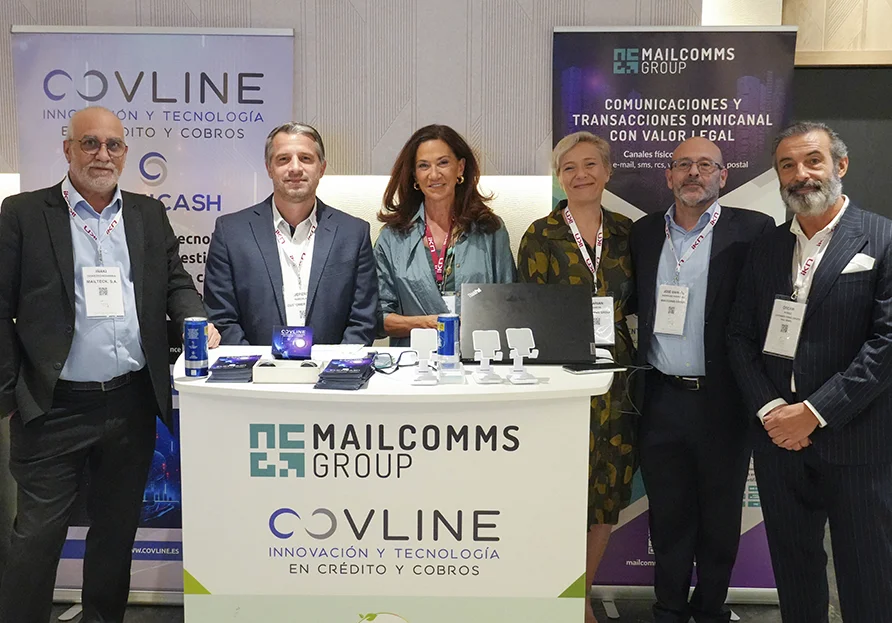Managing credit, collections, recoveries and outages is surely one of the biggest challenges in the relationship between an energy company and its customers. However, it can be done with maximum efficiency and guaranteed compliance. In the specific case of MET Energía, we work by combining the Eloficash solution (from our partner Covline), AI, intelligent digitalization and our certified legal communications service. We talked about all this in our talk at the eighth edition of Future Utility, held on October 16 in Madrid.
The first thing we want to tell you is that the conversation was three-way: end customer, technology provider and trusted partner, which ensures a practical, solution-oriented and results-oriented approach. The participants were Ruth Ortega, Head of Controlling and Credit Risk Manager of our client MET Energía, Pablo Mauad, commercial director of COVLINE and Teresa Arandilla, commercial director of Legal Communications of MailComms Group.
Once the conversation was introduced, Ruth Ortega presented MET Energía to the attendees and highlighted the main points to be taken into account when managing defaults efficiently and, very importantly, in accordance with the regulations in a highly regulated sector:
- Anticipation. By integrating data into a single tool, we can identify potential problems and resolve them in a timely manner.
- Customer segmentation. To implement more effective and personalized strategies in terms of collection management and thus recover debt and prevent non-payments. “We do not treat a household, a company or the public administration in the same way in our business.”
- Reporting (monitoring and control). It allows you to anticipate problems and thus make informed decisions.
- Automation of certified communications. It ensures regulatory compliance while having a very positive impact on the debt recovery rate. In addition, it frees up resources in the work teams by minimizing errors.
- Traceability. In other words, total control over each file.
 Then, the MET Energía representative explained the company’s decision to rely on Eloficash to manage these processes, in a dialogue with Pablo Mauad: “Our main motivation was the need to scale processes in a context of strong growth in the electricity business. More than a tool, we were looking for a solution that would help us manage the processes of credit risk, collection of non-payments, reporting and sending of reliable communications”.
Then, the MET Energía representative explained the company’s decision to rely on Eloficash to manage these processes, in a dialogue with Pablo Mauad: “Our main motivation was the need to scale processes in a context of strong growth in the electricity business. More than a tool, we were looking for a solution that would help us manage the processes of credit risk, collection of non-payments, reporting and sending of reliable communications”.
At this point, the talk was enriched by the participation of Teresa Arandilla, from MailComms Group, to develop the role of legal communications in managing the conversation and notifications with MET Energy users. Thus, the channels currently used by the company to carry out its certified notifications were described: postal bureaufax, emails, calls, SMS and the immediate future was anticipated: WhatsApp and callbots as options to raise efficiency levels, always in a certified manner.
At this stage of the conversation, the importance of being accompanied, for the management of such sensitive processes, by a reliable service provider such as MailComms Group was mentioned . “In the energy sector, communications prior to a power outage are mandatory and must meet very strict legal criteria. It is a highly regulated sector in which having a trusted service provider such as MailComms Group is key. It gives us legal certainty, credibility with the client and guarantees that the recovery processes comply with all regulatory requirements,” commented Ruth.
The end of the session was dedicated to the improvements observed since the integration of the solution:
- Reduction of the time elapsed between the provision of the service and its collection.
- Higher recovery rate in the friendly phase.
- Less need to escalate cases to legal action.
- Savings in administrative time and better experience for the collection team.
- Elimination of the manual tasks involved in sending postal bureaufaxes and their subsequent tracking and tracing.
Finally, significant figures were presented, “in the case of domestic customers alone , we went from managing 300 customers to 15,000 without increasing the number of professionals dedicated to this task”.

